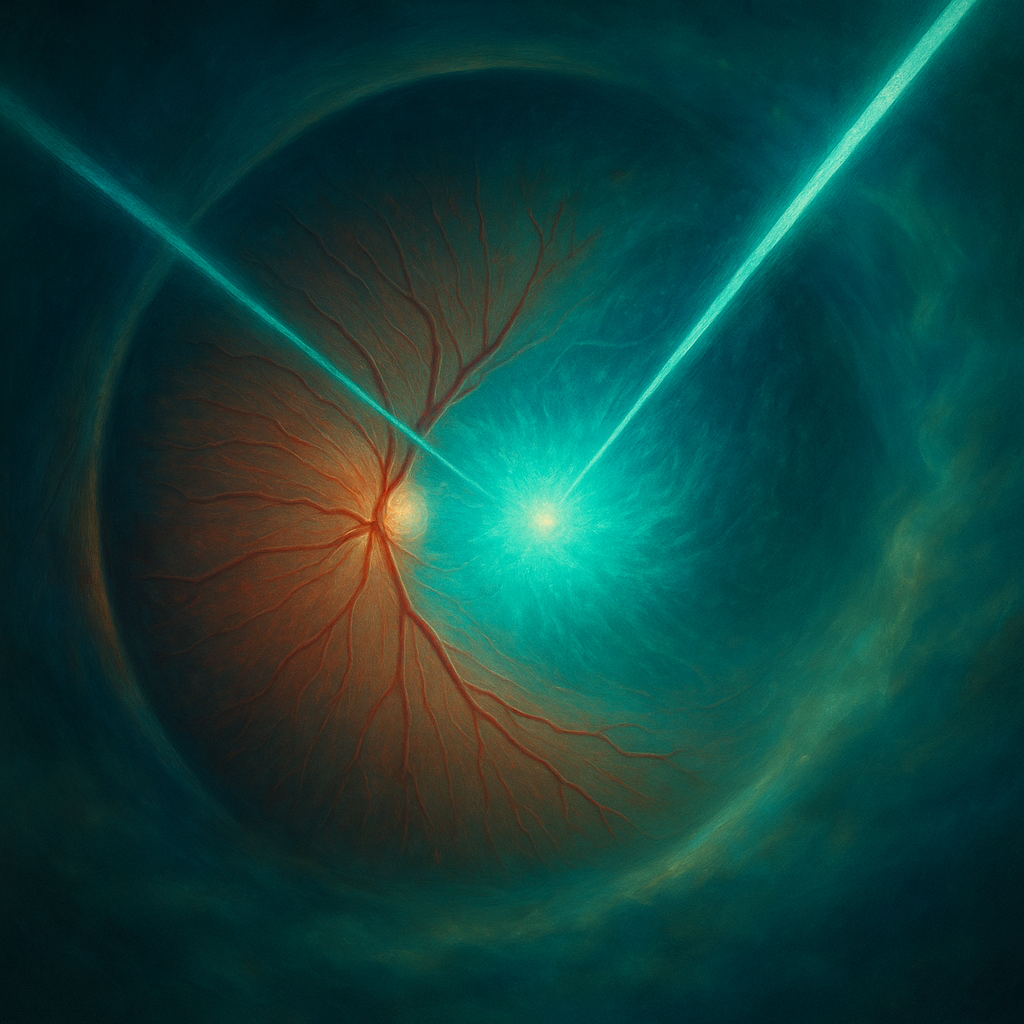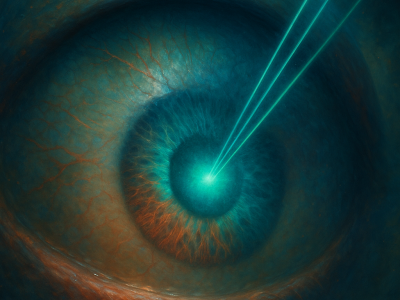What if the colours we know are just a fraction of what’s possible? This question, more at home in the realm of science fiction than science, recently received a bold new answer from researchers in California. In an extraordinary feat of optical neuroscience, scientists have used precise laser light to stimulate individual cells in the human retina, revealing a colour no one has ever seen before.
They’ve called it Olo.
Unlike any hue in the natural world, Olo lies beyond the limits of normal colour perception. It’s not just a new shade, it’s a new phenomenon. And it might just be the beginning of a radical transformation in how humans experience the visual world.
A colour born from lasers and algorithms
At the University of California, Berkeley, a research team led by Professor Ren Ng has developed an advanced technique to manipulate how our eyes and brains perceive colour. Published in Science Advances on 18 April 2025, their study introduces a visual stimulation method known as Oz, a system designed to bypass the natural limitations of human colour vision by targeting individual photoreceptor cells, specifically M cones responsible for detecting green wavelengths.
Normally, when light hits your retina, it activates a combination of three types of cone cells: S (short, blue), M (medium, green), and L (long, red). The brain interprets this mix to construct the colours we see. However, the M cones are sandwiched between the ranges of the L and S cones, meaning that light targeting them always ends up activating neighbouring cones as well. As a result, it is virtually impossible to stimulate only the M cones under natural conditions.
However, by using lasers to deliver microdoses of light directly to specific M cone cells with a precision never achieved before, the researchers effectively bypassed this limitation. The brain, receiving a signal never encountered in evolution, perceived something entirely new.
So, what does Olo look like?
Test participants described Olo as a super-saturated blue-green, something akin to teal but far more vivid than anything in the natural world. “Olo was more saturated than any colour you can see in the real world,” said Ren Ng, who was also one of the five people to see Olo first-hand.
Participants in the study compared Olo to existing colours using sophisticated colour-matching experiments. They couldn’t find any match, not even with the purest monochromatic light available. The only way to approximate Olo was by desaturating it, i.e., adding white light to dull its intensity until it resembled a known shade on the traditional colour wheel.
This means Olo exists outside the natural human gamut, the full range of colours our eyes can naturally detect. It’s not an illusion, nor a trick of language or light. It’s a real, measurable colour created by manipulating the fundamental biological mechanics of vision.
The tech behind the trick
The Oz system is a technological marvel in itself. It relies on a device called an Adaptive Optics Scanning Light Ophthalmoscope (AOSLO) combined with precise real-time eye-tracking. Using infrared light to image the retina and visible light lasers for stimulation, the system delivers over 100,000 microdoses of laser light per second, each one targeting a single cone cell within a visual field just 0.9 degrees across, roughly the apparent width of a full moon in the sky.
Each subject had their retina mapped beforehand, with every cone cell classified by spectral type (L, M, or S). Then, the researchers used a laser set at 543 nanometres (green) to target the M cones, while avoiding any spill-over into L or S cones.
These cone-targeting microdoses simulate dynamic images, including videos, by compensating for eye motion, a task performed with millisecond precision. The Oz prototype cannot just display Olo as a colour swatch; it can create moving images in which Olo forms the background or part of the content.
Why it matters: Implications for colour blindness and vision augmentation
Beyond the sheer spectacle of Olo, the technology carries transformative potential. People with red-green colour blindness (the most common type), lack functioning L or M cones. While gene therapy in monkeys has shown success in restoring trichromatic vision, human trials are complicated and risky.
Oz provides a non-invasive alternative. By delivering signals as if a missing cone were present, the brain might be trained to interpret new colour information, potentially restoring aspects of colour vision without altering a person’s DNA.
Even more intriguingly, this research touches on the prospect of expanding human vision itself. If we can simulate a new cone type, might we one day create humans with tetrachromatic or even pentachromatic vision? These are not just speculative questions anymore. With Oz, we now have a testbed to explore them in real time.
Seeing beyond sight: A neuroscientific leap
To understand just how radical Oz is, consider the history of colour reproduction.
From cave paintings to modern OLED screens, all our visual technologies have operated within the same foundational rulebook: combine a few primary colours to simulate the full range of hues. This is called spectral metamerism.
Oz breaks that rule.
Rather than mixing wavelengths, it sculpts light spatially on the retina, targeting cone cells individually to create new visual outputs. This is known as spatial metamerism, a concept never before realised in practice on this scale.
“This is a completely new platform for studying perception and neuroscience,” the authors note. “It provides programmable, high-resolution control over the first layer of visual processing, something we’ve never had before.”
Limits, controls and criticisms
Of course, Olo is still in its infancy. The experimental area is tiny. The technology is lab-bound and expensive. And stimulating the retina at this resolution is only possible under tightly controlled conditions, including pupil dilation and head fixation.
Critics also question whether a “new colour” is an accurate term. Professor John Barbur of City, University of London, pointed out that manipulating a single cone type can alter brightness and saturation, but this might not constitute a fundamentally new hue.
The researchers responded with rigorous controls: participants no longer saw Olo when they intentionally misaligned the laser’s target (called the “jitter” condition). They simply perceived the colour of the laser itself. That distinction is critical. Without precise stimulation, the illusion collapses.
Moreover, in image and video recognition tests, participants could only detect the orientation of a red line on an Olo background when the stimulation was precisely targeted. This strongly suggests that the perception wasn’t just subjective or imagined. It had clear, testable effects on visual recognition.
Interestingly, this breakthrough seems to fulfil a speculative prediction made over two decades ago. In The Ancestor’s Tale (2004), evolutionary biologist Richard Dawkins asked whether artificially stimulating a single cone cell could produce a colour never seen before. Now, in a letter to The Guardian, he declared: “Makes a nice change to be cast in the role of prophet.”
The ethics and philosophy of new perception
At its core, Olo forces us to confront a deeper philosophical question: What is the nature of reality if perception can be artificially expanded? If the colours we see are constructs of the brain, are there infinite perceptual worlds waiting to be unlocked with the right stimuli?
The ability to programme sight to engineer experience raises ethical issues too. Who gets access to enhanced perception? Should we edit our sensory interfaces the way we update software? What happens when we can see colours others cannot?
These questions, once the stuff of speculative fiction, are fast becoming scientific realities.
What next?
Researchers are already imagining how Oz could be used to explore neural plasticity, the brain’s ability to adapt to new inputs. Could this system train people to perceive new colours permanently? Could children learn to integrate Olo into their everyday perception?
More experiments are underway. The team is attempting to scale up the field of view and allow free-gaze exploration. That means more natural usage, and potentially, broader application in medical or artistic settings.
But even if the technology never leaves the lab, the implications are profound. It proves that the biological limits of vision are not fixed, and that perception can be engineered.
The future of colour is programmable
The discovery of Olo isn’t just a technical achievement; it’s a conceptual leap. For centuries, we assumed that human vision was bounded by biology. We’ve pushed those boundaries outward with lasers and a little wizardry.
Science has reminded us that we don’t see the world as it is, but as we’re built to see it. And perhaps, with the right tools, we can build ourselves to see more.
Could there be colours we haven’t even dreamed of?
If science can show us Olo, what other unseen marvels might lie just outside our perception?
Reference
Fong, J., Doyle, H. K., Wang, C., Boehm, A. E., Herbeck, S. R., Pandiyan, V. P., … & Ng, R. (2025). Novel color via stimulation of individual photoreceptors at population scale. Science Advances, 11(16), eadu1052. https://www.science.org/doi/full/10.1126/sciadv.adu1052







